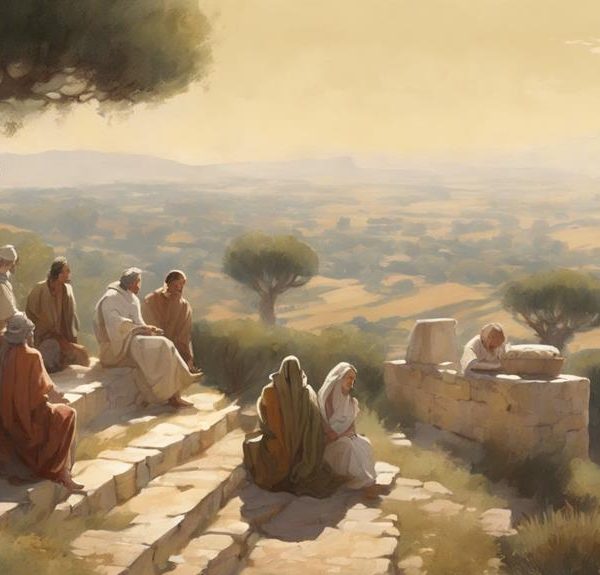Gain fresh insights into biblical narratives through the profound symbolism of scrip, revealing hidden layers of meaning in familiar stories.

Scrip in the Bible
In ancient texts and religious scriptures, you'll find many items of seemingly mundane nature holding profound significance; scrip, a small bag or pouch mentioned in the Bible, is no exception.
You've likely encountered its mention without giving much thought to its deeper cultural and theological implications. But what if you knew that understanding the historical context and symbolic meanings of scrip could offer fresh insights into familiar biblical stories?
Let's explore how this simple item weaves through narratives of provision, trust, and journey, inviting you to uncover layers of meaning that could enrich your interpretation of these ancient texts.
Key Takeaways
- Scrip, a pouch for provisions, symbolizes faith and reliance on divine provision in biblical narratives.
- Its usage reflects socio-economic practices and values of the era, providing cultural insights.
- Variations in translation (e.g., 'bag' or 'pouch') highlight its commonality across different biblical stories.
- Modern interpretations view scrip as a metaphor for spiritual preparedness and simplicity in faith.
Definition and Origins

Scrip, a term encountered in biblical texts, originally refers to a small pouch or wallet used by travelers and pilgrims to carry provisions or money, highlighting the practical aspects of ancient journeys. The linguistic evolution of 'scrip' is a fascinating journey in itself, tracing back to Late Latin and Old French, wherein its meanings and applications varied significantly over centuries. This etymological progression underscores not only the dynamic nature of language but also reveals the layers of historical inaccuracies that may arise when interpreting ancient texts without a nuanced understanding of their original contexts.
In your analysis of scrip's origins, you delve into the realms of historical linguistics and textual criticism, uncovering discrepancies between modern interpretations and historical realities. These inaccuracies aren't mere semantic errors but are indicative of the broader challenges faced by scholars in reconstructing the past with fidelity. They serve as a potent reminder that historical artifacts, including words, must be carefully contextualized within their specific temporal and cultural milieu to avoid anachronistic interpretations and to ensure a more accurate reconstruction of historical narratives. This scholarly endeavor not only enriches your understanding of biblical times but also enhances the precision and reliability of historical knowledge.
Biblical Appearances

In several instances within the biblical narrative, travelers and pilgrims are depicted carrying a small pouch or wallet, known as a scrip, underscoring its practical significance in ancient journeys. This element not only adds a layer of realism to the stories but also serves as a cultural anchor, providing insights into the everyday life of the people during the times depicted in the Bible.
The mention of scrips across various books highlights their ubiquity and the vital role they played in the historical contexts of the Bible. These references aren't merely incidental; they're woven into the fabric of the narrative, reflecting the socio-economic practices of the times. The scrip, often used for carrying food, money, or small personal items, symbolizes the itinerant lifestyle of many biblical characters, from prophets to apostles.
However, it's essential to consider translation variations when examining the biblical mentions of scrips. Different translations and versions of the Bible may use alternate terms, such as 'bag,' 'pouch,' or 'wallet,' to describe the scrip. These variations can influence one's understanding of the text, highlighting the importance of contextual and scholarly analysis in interpreting these references accurately.
Cultural Significance

Beyond its practicality for ancient travelers, the scrip holds deep cultural significance, shedding light on the intricate societal values and norms of biblical times. Its presence and use reveal much about the daily lives, travels, and spiritual practices of the people during this era. By examining the scrip's role, you delve into a rich tapestry of cultural and historical context that informs not only religious studies but also our understanding of ancient societies.
To keep you engaged, consider these points:
- The scrip as a symbol in artistic representations, often illustrating biblical narratives and the everyday life of the period.
- Its depiction in historical texts and artifacts, offering clues about the socio-economic conditions of the time.
- The role of the scrip in fostering community and hospitality, as carrying one often implied a journey reliant on the kindness of strangers.
- How the understanding of the scrip's function has evolved, reflecting changes in scholarly interpretations and insights into ancient customs.
These aspects underscore the scrip's more than utilitarian role, positioning it as a key to unlocking the historical context and societal values embedded within biblical stories and artistic representations.
Lessons on Provision

Exploring the cultural significance of the scrip also invites a closer examination of its fundamental role in teaching about provision within biblical narratives. The scrip, a modest bag used for carrying provisions, emerges not just as a physical artifact but as a symbol steeped in lessons of faith growth and reliance on divine provision. These narratives underscore trust exercises between the divine and the faithful, illustrating a profound reliance on spiritual rather than material sustenance.
In these stories, the scrip often represents the minimal physical belongings one might carry, emphasizing a journey of faith where material possessions are secondary to spiritual wealth. This notion encourages believers to prioritize their spiritual journey and trust in divine provision for their needs. The recurring motif of the scrip in these accounts serves as a tangible reminder of the importance of faith growth through trust exercises. It's through this lens that the scrip transcends its physical utility, embodying a deeper theological significance.
The biblical portrayal of the scrip thus becomes a pedagogical tool, teaching followers the virtues of simplicity, faith, and trust in divine provision. Through this analysis, one appreciates how the scrip's thematic presence in biblical stories contributes to a richer understanding of faith growth and the exercises of trust it entails.
Modern Interpretations

As we delve into modern interpretations of the scrip, it's crucial to understand how contemporary perspectives reshaped its biblical significance, reflecting evolving theological insights and cultural shifts. The ancient concept of scrip, once a tangible provision for journeying disciples, now finds its relevance in discussions that bridge scriptural traditions with today's digital and ethical landscapes. This evolution is marked by:
- The rise of digital evangelism, highlighting how spiritual teachings adapt to new mediums.
- Debates over the material versus spiritual provisions in faith communities.
- Interpretive controversies, where scholars and believers alike wrestle with applying ancient texts to modern dilemmas.
- The exploration of scrip as a metaphor for spiritual preparedness in a rapidly changing world.
These aspects underscore the dynamic nature of biblical interpretation, where the ancient text meets modernity. The transition from physical scrip to its metaphorical implications today invites a broader reflection on how scripture informs contemporary life.
This analytical journey through modern interpretations not only enriches our understanding of the scrip but also challenges us to consider how ancient wisdom can guide us in the digital age, amidst ongoing interpretive controversies.
Frequently Asked Questions
How Has the Concept of Scrip Influenced Legal and Economic Systems in Historical Contexts Outside of Biblical Narratives?
Outside biblical narratives, the concept of scrip has significantly shaped legal and economic systems. You'll find that scrip legislation has often been pivotal in developing economic models, especially in closed economies or during periods of currency instability.
This form of non-traditional currency not only influenced trade and labor markets but also led to innovative financial instruments. Its impact on historical economic practices demonstrates the adaptability and resilience of communities facing monetary challenges.
Are There Any Religious Denominations or Groups Today That Still Use or Promote the Use of Scrip Based on Its Biblical Significance?
You're diving into whether modern religious groups still adopt scrip, focusing on its symbolism and adaptations outside ancient texts.
While direct usage is rare, several denominations symbolically integrate scrip principles into practices, emphasizing community support and economic self-sufficiency.
This modern adaptation reflects not just a historical nod but a meaningful embrace of communal values, where the exchange transcends monetary value, reinforcing bonds and collective identity among believers.
How Does the Portrayal of Scrip in the Bible Compare to Its Depiction in Other Religious or Historical Texts From the Same Era?
When comparing scrip's portrayal across different texts, you'll find its symbolism and cultural interpretations vary.
Unlike its specific, often spiritual significance in biblical narratives, other historical or religious documents may present scrip more as a mundane tool or a purely economic asset.
This discrepancy highlights how cultural contexts shape the understanding and importance of objects, suggesting that what's seen as sacred in one tradition could be regarded as commonplace or secular in another.
What Are the Ethical Implications of Using Scrip in Contemporary Society, Especially in Light of Biblical Teachings on Wealth and Poverty?
You're diving into the ethical challenges of using digital currency in tackling modern poverty, questioning its alignment with biblical teachings on wealth and poverty.
The crux lies in whether such methods advance equity or deepen disparities. As you analyze, consider how digital currency's ethics intertwine with solutions to poverty.
It's crucial to ensure these modern approaches don't stray from the foundational values of fairness and compassion highlighted in religious teachings.
Can the Use of Scrip in the Bible Be Linked to Any Specific Archaeological Findings or Historical Events That Provide Additional Context to Its Significance?
You're exploring how scrip symbolism and ancient economies intersect with specific archaeological findings or historical events. It's crucial to analyze the evidence critically, considering how the use of scrip reflects the economic practices and societal values of ancient cultures.
Conclusion
In conclusion, you've explored the multifaceted role of the scrip in biblical contexts, its cultural resonance, and contemporary interpretations.
You've seen how it symbolizes provision, faith, and simplicity. Analyzing its appearances and significance deepens your understanding of its enduring legacy.
This exploration underscores its relevance, offering insights into the lessons of provision and trust that remain pertinent today. Thus, the scrip isn't just a historical artifact; it's a profound symbol woven into the fabric of faith and daily life.



Sign up